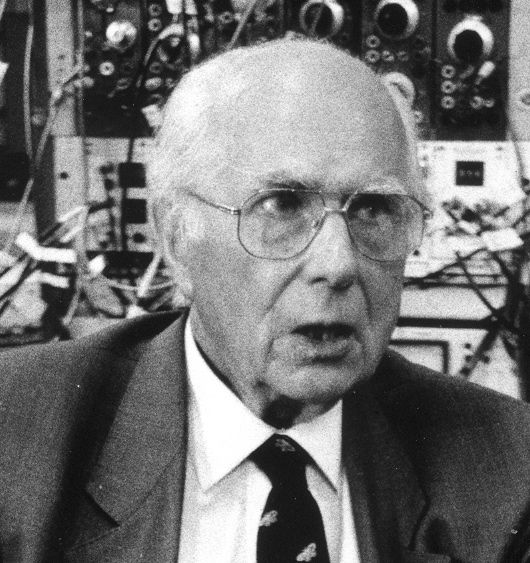
Physiology News Magazine
Obituary: Andrew Fielding Huxley
1917-2012
Membership
Obituary: Andrew Fielding Huxley
1917-2012
Membership
Christopher Huang
https://doi.org/10.36866/pn.88.48

Sir Andrew Huxley was an epoch-making pioneer in the physiology and biophysics of nerve conduction, and skeletal muscle activation and tension generation. He was born in London within an illustrious intellectual family, and educated at University College (1925–30) and Westminster Schools (1930–5), and Trinity College, Cambridge (1935–9), his interests leading him to read Part II Physiology in the Natural Sciences Tripos (1938–9). His research began with Alan Hodgkin in 1939 on the properties of the propagated impulse in giant axons of squid. This groundbreaking work on nerve excitability in the Cambridge Physiological Laboratory and the Plymouth Marine Biological Laboratory applied the voltage-clamp technique to characterize the properties of membrane sodium and potassium permeabilities and reconstructed their changes during membrane excitation. This provided the basis for our current understanding of how voltage-gated ion channels generate propagating action potentials. It led to his being awarded the 1963 Nobel Prize for Physiology and Medicine with Alan Hodgkin and Jack Eccles.
This led to a cascade of important discoveries culminating in our current understanding of excitable tissue function. Those bearing upon the fundamentals of channel function included the demonstration of gating currents and their application in characterizing molecular configurational changes underlying channel activation. Demonstration of the unit channel events through single ionic channels underlying the observed conductances led to award of the 1991 Nobel Prize to Erwin Neher and Bert Sakmann, and to recent biochemical characterizations of sodium channel structure and of its gating transitions. Both the voltage-clamp techniques and their associated mathematical formulations were to be generalized to other excitable tissues, including mammalian nerve, and skeletal and cardiac muscle, as well as encoding processes in repetitively firing nerve cells. They also led to mathematical analyses reconstructing the cellular homeostatic effects not only of electrogenic but also electroneutral and osmotic fluxes and metabolic change. Finally, their translational applications bear on demyelinating disease, our understanding of pain and anaesthesia, and of electrophysiological and arrhythmic disease in skeletal and cardiac muscle. These include Huxley’s own work on the function of the myelin sheath in vertebrate nerve fibres in saltatory impulse conduction.
Huxley performed groundbreaking work of similar importance on muscle activation and contraction whilst at University College London. He demonstrated the means by which surface membrane excitation in skeletal muscle is transmitted into the fibre interior to initiate myofilament activation by the transverse tubules. This prompted subsequent strategic work clarifying the electrophysiological role of the transverse tubules in spreading excitation into the muscle interior, as well as its molecular coupling processes triggering release of intracellularly stored Ca2+. In the meantime, Huxley turned to the muscle contractile process itself, proposing and establishing the sliding filament theory of muscle contraction through comparing the expected extents of actin and myosin filament overlap with their resulting isometric muscle tension. He then proposed a model for crossbridge interaction for these myofilament interactions, on the basis of their observed tension transients. This proposed crossbridge cycles involving elastic and stepwise-shortening elements driven by actin–myosin binding through a sequence of attachment sites, followed by crossbridge detachment and ATP hydrolysis. This completed his momentous contributions to physiology, as “the mechanical engineering of living things”.
Sir Andrew was elected to the Royal Society in 1955 and was its President between 1980 and 1985. He became Jodrell Professor of Physiology in 1960, then Royal Society Research Professor in University College London in 1969. He was Master of Trinity College, Cambridge between 1984 and 1990, knighted in 1974 and appointed Order of Merit in 1983. He was elected Ordinary and Honorary Member of The Physiological Society in 1942 and 1979 and served on the Editorial Board of The Journal of Physiology (1950–57) and its Committee (1957–61; 1970–4). In 1947 Andrew Huxley married Jocelyn Richenda Gammell Pease who predeceased him in 2003. They have five daughters and a son.
